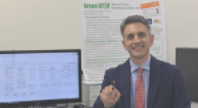NUS develops permanent micro-vision processing chips
The National University of Singapore (NUS) research team has developed a miniature vision processing chip called "EQSCALE". The chip captures visual detail from video at very low power consumption and consumes 20 times less power than competing best-in-class chips, reducing the size of the smart vision system to millimeters and continuously supplying power to millimeter-scale solar cells without the need for replacement. The battery can be used in a wide range of Internet of Things (IoT) applications such as security surveillance and building energy management.
According to reports, under the leadership of Massimo Alioto, an associate professor in the Department of Electronics and Computer Engineering at the NUS School of Engineering, the team has developed an important step in the use of near-permanent millimeter-scale smart monitors. It will also pave the way for IoT applications such as ubiquitous security surveillance at airports and critical infrastructure, building energy management, workplace safety and aged care.
The video feature capture chip captures the visual details captured by the smart monitor and turns it into interesting points and edges for further analysis. Video feature capture is the foundation of any computer vision system that automatically detects, classifies, and tracks objects in a visual scene.

But it needs to be done continuously in each frame, thus defining the minimum power of the intelligent vision system, and even the smallest system size. The advanced chips used to capture features previously ranged from a few milliwatts to a few hundred milliwatts, the average power consumption of smart watches and smart phones.
In order to achieve near-permanent operation, such a device can be powered by a solar cell, but requires a solar cell of a size of centimeter or more, thus posing a fundamental limitation on its miniaturization. To reduce it to the millimeter level, you must reduce the power consumption to less than 1 milliwatt.
Alioto said that IoT applications must use large-scale distributed sensors, but due to high power consumption and size constraints, long-life vision electronic systems are currently not suitable for IoT applications. But the EQSCALE chip has overcome these challenges and has proven the viability of a ubiquitous, always-on smart monitor.
The NUS engineering team's EQSCALE chip enables continuous feature extraction at 0.2 mW and consumes 20 times less power than the prior art. This means a significant advancement in the miniaturization of smart vision systems. The new feature picker is less than 1 mm on each side and can be continuously powered by solar cells that are only a few millimeters in size.
According to Alioto, this technological breakthrough is achieved through the concept of energy-quality scaling, which adjusts between the energy consumed and the quality of the features captured, simulating the dynamic changes in concentration when humans observe visual scenes. And handle visual scenes with different details and quality according to the task at hand. Even if a large number of points of interest are missed due to the degradation of the target quality, the object can be correctly identified.
The EQSCALE chip is a key step in the future of a millimeter-scale vision system that can be operated permanently. The NUS research team is developing a miniaturized computer vision system that includes a smart monitor equipped with this chip and a machine learning engine for understanding visual scenes. The ultimate goal is to provide a large-scale distributed vision system for large-scale and ubiquitous visual surveillance that goes far beyond traditional monitor concepts.
Mc4 Solar Connector,Mc4 Connect,Mc4 Branch Connector,Mc4 Y Connector
Sowell Electric CO., LTD. , https://www.sowellsolar.com
